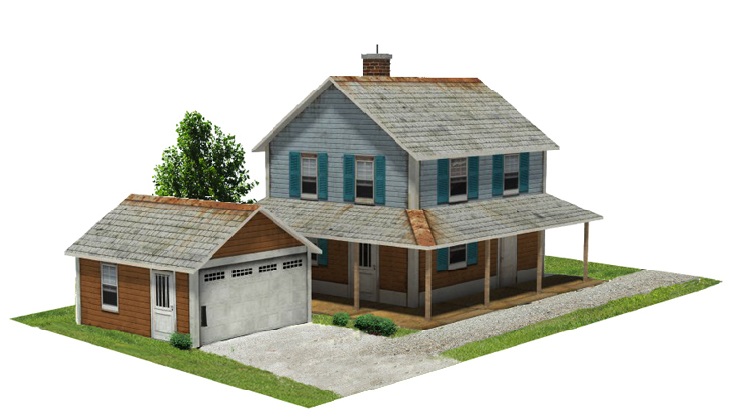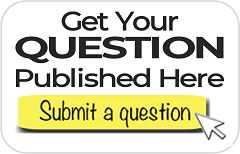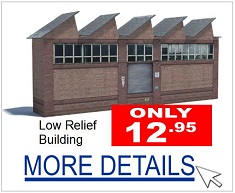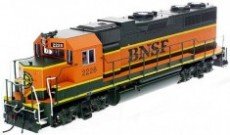Everything on model trains, model railroads, model railways, locomotives, model train layouts, scenery, wiring, DCC and more. Enjoy the world's best hobby... model railroading!
How to Give Your Railroad the Illusion of Size
Space limitations are a problem for most model railroaders, so the use of every square foot needs to be well thought out, from both an operational and visual view point. There’s nothing worse than a layout that looks cluttered.
Several clever visual techniques can be applied to provide the illusion of space and distance. Although the following tips seem logical, they are sometimes overlooked by many in the hobby.
1. Where appropriate, sort your objects into sizes placing the bigger objects towards front and the smaller objects behind. I appreciate this is not always practical, especially if you plan to position a big industrial building against the backdrop (that would make sense).
The point I’m making is that if you have, for example, residential houses, the ones at the front should look bigger than the one’s in the far distance. If they are all the same size – the layout can lack perspective. A big advantage of downloadable kits (over plastic kits) is they can easily be reduced in size by 5%, 10%, or even more, so buildings that are supposedly miles away can be smaller than those in the foreground.
2. Be aware that bold colors standout, whereas objects with softer colors and tones fade into the distance. A light, muted, object with grayer shades and soft edges at the back of a layout can appear to be located miles into the distance. Strong, bright, vivid, sharp objects against the backdrop will look much closer. So, to make bushes, trees and other vegetation recede into the distance; make the colors less bold, less sharp and less detailed.
3. Objects that are lower will appear as though they are further away, whereas higher objects will seem closer.
4. Position thin ‘low-relief’ buildings up against the back of the layout, as they will require less space, yet still add illusion of perspective and distance to the scene.
And tips added by readers:
5. Judicially placed mirrors can also create the illusion of a bigger layout (thanks Denis)
6. Road positioned at angles disappearing in the distance behind vegetation, buildings, or hills makes the layout look longer and wider (thanks Bud)
ANNOUNCING! Introductory 70% Saving Off 8 New HO, OO, N Scale House Model Designs
The new series of 8 downloadable scale model homes with 4 garages is now available at a special introductory price saving 70%. These scale models are enjoyable to build and very authentic in appearance, because they include photo-realistic pre-done weathering and detailing. This short video will give you are good close up look.
You download the PDF plans as OO scale, and simply adjust your printer settings to scale them to HO scale or N scale. That’s simple – the web page shows how. You can make several houses from each design if you choose, without having to pay for another download. Easy to follow assembly diagrams and instructions are included.
Go here to grab this 70% saving today
http://www.modelbuildings.org/scale-houses-8-house-models-to-make.html
How To Hide An N Scale Ramp
Shaun asks readers for ideas:
“I am wanting ideas on how I could hide the ramp on my N scale layout as the next two tracks are a railway station. The down track and the one above the ramp are 40mm apart. I don’t know what to do with tracks 1 – 5. I am thinking of putting mountains to form a partition stright down the middle (lengthwise).”
Do I Need 2 Decoders For Sound & Loco Operation?
Club member Don asks readers:
“I plan to change over to DCC, and want to know for sound if I need to instal two decoders, or will the sound decoder also perform like an ordinary decoder to operate the locomotive?”
“My train club buddies laughed when I downloaded this house plan, but when they saw it constructed on my model railroad layout… …they began asking me questions!”
Yes, you can make a model house just like this and impress visitors to your layout.
This very real looking scale model house is one of 8 in the latest series of downloadable buildings. It even has a garage!
As you can see the standard of weathering and detailing is first class, and the good thing is that the weathering is already done for you, so the model you make will look as real as this. These models are easily scaled to H, N scale, or OO, and no painting or airbrushing is required to achieve the realistic weathering effects. Enlarging the designs to O or G scale is not recommended as the printing clarity reduces when they’re scaled to large. See the other 7 house here.
What is the Correct Weight For HO Wagons?
Club member Albert asks readers:
“Can someone enlighten me as to the right weight for an HO wagon so that it will on the track especially around curves and on turnouts? I guess what I am asking is – 30 foot = total ounces of car – 40 foot = total ounces of car – 50 foot = total ounces of car. I am hoping someone can help. Thanks.”
How To Maintain Smooth Running Track
Hedley asks readers:
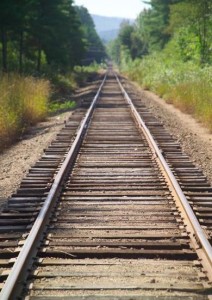 “What’s the best way to keep my track in top condition so my HO trains run smoother? I have used a fine sand paper, but a railroading buddy said rubbing alcohol is better. I’m confused – should I use sandpaper, or rubbing alcohol, both, or something else?
“What’s the best way to keep my track in top condition so my HO trains run smoother? I have used a fine sand paper, but a railroading buddy said rubbing alcohol is better. I’m confused – should I use sandpaper, or rubbing alcohol, both, or something else?
What Paper For Cardboard Buildings?
Dave asks readers:
“I see advertisements for printable structures here and elsewhere but they always seem to come from England. I live in USA and can’t seem to find the paper sizes and thicknesses necessary to complete them. Legal paper can substitute for A4, but not the referenced card stock. Anyone have ideas on how to get around this problem?”
Robert comments… Dave, the buildings advertised on this site are designed in Australia and are based on buildings from the USA, Canada, UK, Australia, New Zealand, and other countries. They are designed to international paper size A4 which is very similar in size to US letter paper. It is very easy to adjust the printing size on a home printer if needed. Most people use ordinary home printing paper, however you can substitute other paper or card stocks if preferred. There are no hard and fast rules… it really comes down to personal preference.
How to Make Natural Water Effects Using Epoxy Resin
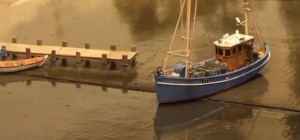 There are several ways to make artificial water for a model railroad, and some are more permanent and realistic than others. Epoxy resin products are a popular choice for many as they dry hard and clear (although color can be added to the mix). Regular epoxy resin is available art & craft stores in a twin bottle pack. One bottle contains resin and the other is the hardener which causes a chemical reaction when mixed together. The mixture warms up and dries rock solid. When dry it cannot be molded or melted, but it can be sanded. There are also several branded products available for making artificial water including Realistic Water, and E-Z Water.
There are several ways to make artificial water for a model railroad, and some are more permanent and realistic than others. Epoxy resin products are a popular choice for many as they dry hard and clear (although color can be added to the mix). Regular epoxy resin is available art & craft stores in a twin bottle pack. One bottle contains resin and the other is the hardener which causes a chemical reaction when mixed together. The mixture warms up and dries rock solid. When dry it cannot be molded or melted, but it can be sanded. There are also several branded products available for making artificial water including Realistic Water, and E-Z Water.
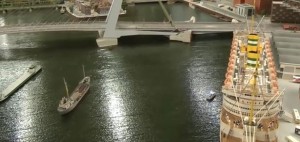 Making the water look real
Making the water look real
In real life water changes color due to reflections on the surface, and/or the clarity of the water, and/or the depth, and/or the movement/stillness, and/or the rocks/debris/sand color on the bottom. So water is not always blue (as you can see from these model railroad photos).
Rivers often have a high particle content so look brown in color. On the other hand a river might be relatively clean, but be discolored in places due to outfall pipes from factories or input flows from another stream. So to look real the clarity and color might not be consistent.
More info on making water for model railroads.
Model the bottom first
When creating a water area on a model railroad, the first job is to model and shape the bottom remembering that is unlikely to be perfectly smooth. Little stones and vegetation can be added depending on the intended water depth. The bottom will require painting prior to pouring the resin mix. The color choice is important and needs take into account the various factors mentioned earlier. Greens, browns, and blue tones are a common choice. Boats, watercraft, vegetation etc is often added to the liquid resin before it hardens. Plants such as fallen branches, reeds, brushes, grasses etc. can be added along a river bank.
POLL RESULTS: How near to completion is your railroad?
318 people voted in last weeks poll which asked: How near to completion is your railroad?
Results were:
>> My railroad is an evolving process and will never be complete (29%)
>> I’m only in the planning stage and am yet to get started (24%)
>> I’ve started construction, but am less than 50% complete (24%)
>> My construction is more than 50% complete (8%)
>> I’m almost finished construction (4%)
>> The construction stage is now complete (3%)
>> Unfortunately I don’t have a layout yet (8%)
Demonstration: How To Build Intermodel Shipping Container Models
This 2 minute video shows the simply process of constructing scale model shipping containers for positioning next to railroad track, on flat cars, or stacked behind industrial buildings or work sites. They look so real with all the rust marks, scratches, shipping logos etc. There are 40 designs in the series ranging from 10ft through to 20ft and 40ft containers.
How To Fix Shorts When Powering Up Locos
Jim asks readers:
“I have a DC HO layout after redoing part of the layout a short has developed which only allows me to power up to about 1/3. If I go beyond this I get a short. If I back down the power the train will slowly start to run. I have already checked over the layout for shorts. My question – could a turn out be causing the problem?”








